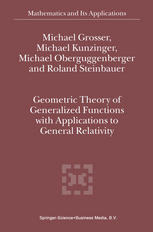

Most ebook files are in PDF format, so you can easily read them using various software such as Foxit Reader or directly on the Google Chrome browser.
Some ebook files are released by publishers in other formats such as .awz, .mobi, .epub, .fb2, etc. You may need to install specific software to read these formats on mobile/PC, such as Calibre.
Please read the tutorial at this link: https://ebookbell.com/faq
We offer FREE conversion to the popular formats you request; however, this may take some time. Therefore, right after payment, please email us, and we will try to provide the service as quickly as possible.
For some exceptional file formats or broken links (if any), please refrain from opening any disputes. Instead, email us first, and we will try to assist within a maximum of 6 hours.
EbookBell Team

4.1
50 reviewsOver the past few years a certain shift of focus within the theory of algebras of generalized functions (in the sense of J. F. Colombeau) has taken place. Originating in infinite dimensional analysis and initially applied mainly to problems in nonlinear partial differential equations involving singularities, the theory has undergone a change both in in ternal structure and scope of applicability, due to a growing number of applications to questions of a more geometric nature. The present book is intended to provide an in-depth presentation of these develop ments comprising its structural aspects within the theory of generalized functions as well as a (selective but, as we hope, representative) set of applications. This main purpose of the book is accompanied by a number of sub ordinate goals which we were aiming at when arranging the material included here. First, despite the fact that by now several excellent mono graphs on Colombeau algebras are available, we have decided to give a self-contained introduction to the field in Chapter 1. Our motivation for this decision derives from two main features of our approach. On the one hand, in contrast to other treatments of the subject we base our intro duction to the field on the so-called special variant of the algebras, which makes many of the fundamental ideas of the field particularly transpar ent and at the same time facilitates and motivates the introduction of the more involved concepts treated later in the chapter.